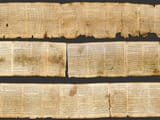Anonymous
ID: gsXwgaE4
6/12/2025, 10:05:03 PM No.507128063
How did they know this about gemstones 2000 years ago?
>In the past century, it has been discovered that gems can be classified as either anisotropic or isotropic, and only recently have scientists discovered cross-polarized light, which can be used to identify whether a gem is anisotropic or isotropic. When viewed in crossed-polarized light (“pure” light), anisotropic stones produce a colorful array- reflecting all the colors of the rainbow, whereas isotropic stones lose all of their colors and appear black. In Revelation chapter 21 there are 12 gems mentioned to be inlaid for decoration of the New Jerusalem, and ALL of these 12 gems are anisotropic gems (gems that can show colorful patterns under pure light)
>Neither diamonds, rubies nor garnets are mentioned, despite the fact that this group of gems is very common. >The precious stones are generally considered to be diamonds, rubies, sapphires, and emeralds, with all other gemstones being semi-precious. Because they are isotropic, when pure light passes through them, there is no beauty at all
>Of the 28 stones that are normally regarded as gemstones, only 16 are anisotropic. God chose the stones for the foundation of the new temple, avoiding stones that would lose their color, and instead chose stones that disperse light to produce brilliant rainbow effects, even before we understood the unique feature of these stones.
>"...and there was a rainbow round about the throne, in sight like unto an emerald." (Revelation 4:3)
https://www.afloodofhope.com/post/gems-and-minerals-in-the-bible
https://youtu.be/JhC6iPuh4XM
>In the past century, it has been discovered that gems can be classified as either anisotropic or isotropic, and only recently have scientists discovered cross-polarized light, which can be used to identify whether a gem is anisotropic or isotropic. When viewed in crossed-polarized light (“pure” light), anisotropic stones produce a colorful array- reflecting all the colors of the rainbow, whereas isotropic stones lose all of their colors and appear black. In Revelation chapter 21 there are 12 gems mentioned to be inlaid for decoration of the New Jerusalem, and ALL of these 12 gems are anisotropic gems (gems that can show colorful patterns under pure light)
>Neither diamonds, rubies nor garnets are mentioned, despite the fact that this group of gems is very common. >The precious stones are generally considered to be diamonds, rubies, sapphires, and emeralds, with all other gemstones being semi-precious. Because they are isotropic, when pure light passes through them, there is no beauty at all
>Of the 28 stones that are normally regarded as gemstones, only 16 are anisotropic. God chose the stones for the foundation of the new temple, avoiding stones that would lose their color, and instead chose stones that disperse light to produce brilliant rainbow effects, even before we understood the unique feature of these stones.
>"...and there was a rainbow round about the throne, in sight like unto an emerald." (Revelation 4:3)
https://www.afloodofhope.com/post/gems-and-minerals-in-the-bible
https://youtu.be/JhC6iPuh4XM
Replies:


